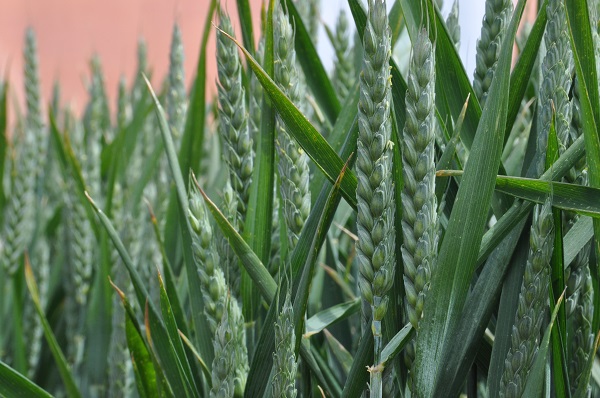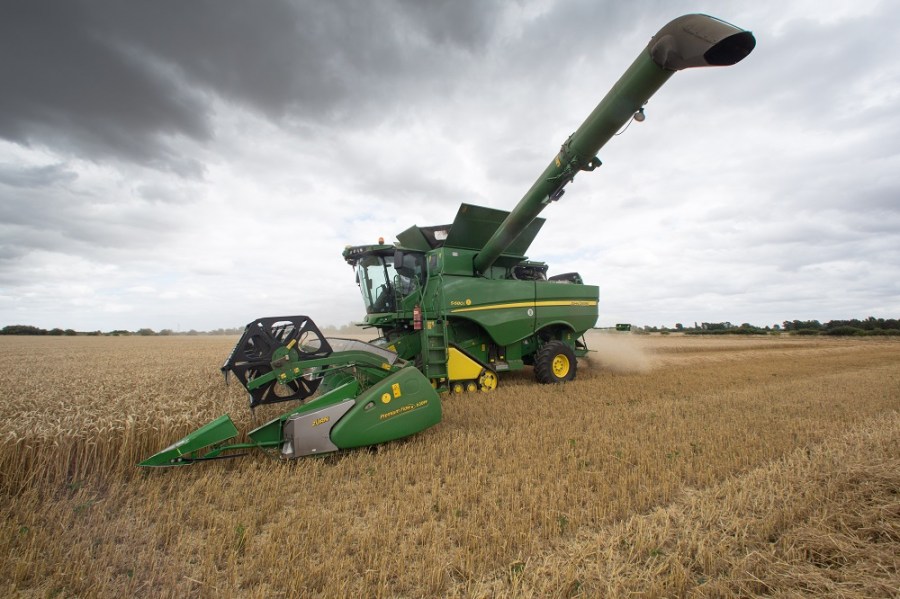You’ll never be able to predict what the grain market will do, but you can stack the odds in your favour and build decisions on robust variety choices. CPM seeks expert advice.
Growing a quality variety without an adequate plan in place can leave you caught in the middle of knowing which market to go for.
By Tom Allen-Stevens
When commodity markets take a downturn, there are two responses often made which, arguably, seldom result in a favourable financial outcome. The first is to hang on to your grain in the hope the market recovers and the second is to jump into a new crop or market in which you have no experience on the basis of dismal returns from the one you’re familiar with.
Both are understandable reactions in pursuit of a logical outcome, but Stuart Hill of Frontier believes a more planned, strategic approach to crop marketing and variety choice is far more fruitful.
“If the aim is a long-term resilient farming system, this requires a suitable balance of cropping and varieties to match market opportunity, and an ability to deal with agronomic issues that will lead to higher yields and lower costs of production,” he notes.
Doggedly pursued
Costs themselves are often doggedly pursued to improve returns. “It’s essential to know your own costs, and these can be used as a benchmark to measure progression, but costs are just one aspect for analysis. At the other end, yield is king – it dilutes the cost of production.”
What’s more, securing a consistent favourable return from the market is fundamental to a profitable crop, he continues. “But growing a quality variety without an adequate plan in place can leave you caught in the middle of knowing which market to go for.”
Increasingly, agronomic issues rather than commodity markets, dictate cropping for an arable business. “With blackgrass, spring cropping is becoming a more significant option – spring barley is now the second biggest crop after wheat, while oilseed rape has fallen back. Later drilling and managing seed rates using precision techniques are options in low to moderate, well managed situations and varieties should be chosen carefully according to their development.
“Managing disease risk is critical, especially in the case of Septoria tritici in wheat varieties and more recently light leaf spot in OSR. Varietal resistance traits now play an important part in providing flexibility, supporting disease control and protecting current chemistry. Coupled with this, those with large acreages will be under pressure to hit the correct spray timings at key leaf stages. A resilient approach is one that spreads this risk by including varieties with higher disease ratings.”
But decisions on cropping and varieties should go hand-in-hand with crop marketing, argues Andrew Hill, grain-

Stocks are high globally, which is why demand across all grains is depressed and prices are relatively low.
trading specialist with Frontier. And currently, commodity markets are showing little sign of an imminent recovery.
“Stocks are high globally, which is why demand across all grains is depressed and prices are relatively low,” he notes. “But there are a lot of factors that move the market up or down. If there’s one thing we can be sure of it’s that the market is volatile and increasingly so. Our view is that it’s best to equip yourself with tools that manage that risk and make the most of the upsides without suffering from the downturns.”
UK growers in a maritime climate have one clear advantage over those in some other countries in that yields are relatively stable – so much of the crop can be sold forward without running too much of a risk of failing to deliver, he says.
Fixed-price contract
“A sensible position to take is to sell a third of the crop pre-harvest, commit a third to a grain pool and sell the final third once it’s in the shed.” Typically, the majority of grain, whether sold forward or post-harvest, is done so on a fixed-price contract. But Andrew Hill encourages growers to explore options that build in more flexibility and often more certainty to the return you can expect.
“Committing to a grain pool works well. Look for one that has a good track record of delivering above the average market price and that offers flexibility on when your grain is moved and payments made. Frontier offers three periods of movement – Oct-Dec, Jan-March and April-June. For harvest 2016, you’d commit by Jan 2016,” he explains.
“Payment would be received at the end of the movement period. But once committed to a pool, you can opt to take early payments to ease cashflow – something a lot of farmers have found useful with the current hold-ups on the Basic Payment Scheme.”
So how can you build a level of certainty into the price you achieve? “Minimum-price contracts offer this,” continues Andrew Hill. These use options to fix the minimum price you receive, but if the market improves, they allow you to take the higher price.
“There’s a cost involved – typically you’d pay £10/t to fix a price of, say £120/t. If the market falls, you exercise your option and would net £110/t. But if it rises, you let the option lapse and cash in.”
For quality crops, there are similar tools that allow you to fix the base price or premium, depending on your view of the market and where you think it may be heading. “For example, if you think the base price for barley currently looks good, but premiums are undervalued, you can fix the base price but allow the premium to float. Conversely, you may think the market has underestimated the size of the quality crop, but that prices overall are poor. So you can fix the premium but allow the base price to float.”
Growers moving into quality crops have a considerable range of options to secure a contract and a price that best suits their situation, points out Andrew Hill. “End users look for a consistent supply of a particular spec, and can offer very favourable terms, especially for multi-year commitments. Frontier has built up good working relationships with a number of end users and their grower groups, so we can facilitate these.”
But he sounds a note of caution for those inexperienced in such markets. “Decide before you sow whether you’re aiming for a feed or quality market. Variety choice is crucial in malting barley contracts, and important for many millers.
“To secure the best deal, you should also be confident you’ll hit the spec – we’ve had two consecutive good quality barley harvests, so those who didn’t meet the right grain N content haven’t achieved a premium. Likewise, the market is likely to be awash with milling wheat after harvest 2016, so if you’re aiming for a premium, focus your efforts on achieving the right spec.”
That said, it’s always worth dealing with a merchant who has good fall-back options should harvest results fall short on what’s expected. “At Frontier, we have access to numerous domestic and export markets to make sure we can secure the correct home depending on grain quality,” he notes.
Frontier seeds manager Chris Piggott echoes the advice on varieties for the quality market. “Spring barley, more than any other crop, is driven by the market on the malting side, and it’s very variety-specific. Propino has been the driver for a number of years, but that’s changing and there are some quite exciting newer varieties, such as RGT Planet, Laureate and KWS Irina.
“With quality wheats, it pays to know what your target market is after. For example, Claire is currently the preferred Group 3 and you might assume that newer varieties on the AHDB Cereals and Oilseeds Recommended List are as marketable as each other. But specific local markets take a different view – there might be a particular variety that meets a local specification.”
KWS Siskin is a variety that holds a lot of promise as a Group 2 wheat, he says, especially with its high yield and good rating for septoria. “It also has good potential for export. If your aim is for a quality outlet, make sure the merchant who sells you your seed is familiar with the specific market opportunities in your area.”
Variety choice should be a three-way conversation that also involves the agronomist, he advises. “Varieties are playing an increasing role in managing disease risk, and newer wheat varieties, such as Skyfall, KWS Lili and Revelation, come with a good disease package that’s been lacking previously. This has been taken a step further with Siskin – it’s untreated yield matches a fungicide-treated Solstice.
“Light leaf spot is becoming more of an issue nationwide and Alizze is a variety recognised for its good performance in the North on this score. DK Extrovert has also been consistent because of its stem canker and light leaf spot resistance,” he adds.
Those drilling later due to blackgrass may favour the strong, leafy growth of KWS Santiago or Skyfall, rather than Cordiale or Relay, that have traditionally taken this slot. “Look across the rotation, too – there’s a tendency to consider a crop or variety’s gross margin in isolation. A more resilient strategy is to balance this with its rotational benefits.”
But the sooner that strategy comes together, the better, says Chris Piggott. “Make a plan early on and stick to it. Keep discussions going with your merchant, as specific options may change as the drilling date approaches – we get a lot of feedback and there are always new opportunities. But the sooner you make your choices for the following year, the more resilient your arable system will become in the long term.”
Shooting stars: Chris Piggott’s top picks for autumn 2016
Winter wheat
KWS Siskin, as one of the highest yielders on the AHDB Recommended List with bread-making potential and good disease resistance, leads the pack and offers exciting opportunities as a first or second wheat. KWS Barrel offers the

KWS Siskin is one of the highest yielders on the RL with bread-making potential and good disease resistance.
same in a Group 3 wheat, with good agronomics and orange wheat blossom midge resistance.
Winter oilseed rape
Conventional variety Elgar looks very promising with high yields and good disease resistance, while Picto is a consistent performer. Hybrid Alizze has a good yield and LLS score, especially in the North. On the candidate list, SY Florida delivers yield with good agronomics and was crucially the earliest to mature in AHDB trials.
Winter barley
None can match the exceptional results of the hybrid barleys, and Bazooka in particular is a variety that stands out. It also produces lots of straw but stands well and competes against blackgrass – it’s an excellent second cereal.
Focus on flexibility ensures a consistent return
Richard Horton likes to keep a close eye on the grain markets. “I follow them fastidiously. If I see a price I like, I’ll go for it,” he says.
With 365ha of combinable crops, he and his father farm around 530ha in total as JE Horton and Partners, based at Northwich, Cheshire. Winter wheat, winter barley, oilseed rape and a small area of oats, with potatoes, rotate around predominantly Grade two, fairly light soils.
He aims to sell around 40-50% of the combinable crop forward, with the bulk of it shifted by Christmas. The rapeseed is all moved at harvest, and rarely will much of the cereal crop be left in the 4000t of on-farm storage by April.
“Cost of production is the starting point – I work out early on what I want to achieve. Last year for example, I was looking for a wheat price ideally of £135/t. It did spike at that price in July, and that’s when we sold a fair proportion of the crop, which turned out to be an inspired move, although it doesn’t always work out that way,” he admits.
With no OSR stored on farm, he has used options in the past to ensure a good price – “they give you a certain amount of security,” he says. He also puts some of the crop through a grain pool. “It makes sense, because markets are so volatile now, compared with ten years ago. Even if just 10% is in a pool it takes a lot of the stress out of marketing the grain, and usually the experts in charge of them achieve a pretty fair price.”
Most of the wheat is grown for milling, and has been for over 15 years, with Solstice the mainstay variety. “We’ve stuck with Solstice because it’s always performed well. “We also have Crusoe and have introduced Skyfall because everyone is banging on about it. Then there’s some KWS Trinity because it performs well on lighter land.”
Achieving the milling spec has rarely been a problem, but he works with local outlets to blend grain that may be of a slightly lower quality. “That’ll be a challenge this year because everyone’s jumping on the milling wheat bandwagon. Fortunately, we’re in an area with plenty of good outlets for the grain – there’s also export opportunity through Liverpool – so we work with traders who can make the most of these markets and bring us a number of options.
“Another important consideration is movement,” he adds. “Frontier has always been very good about moving the grain when we’ve agreed, and that can make a big difference.”
For next year, he reckons they’ll probably stick with Solstice as the milling wheat mainstay. “But much depends on seed availability and how the varieties perform at harvest. For that reason, we prefer to buy from a larger, reputable seed supplier who you can rely on, and can offer a degree of flexibility and a large range of options.”
Arable resilience
As crop prices have fallen, while input costs have been steadily rising, on-farm profitability for UK arable farmers is being squeezed. Only the businesses that have a resilient strategy in place will weather the downturn and emerge fitter and stronger for the opportunities that lie ahead. But what does that mean on farm?
In this sponsored series, CPM has teamed up with experts from Frontier to examine the everyday management decisions and explore what separates a resilient strategy from one that leaves a business exposed to the harsh cuts of an economic downturn. From nutrition and precision farming, through seed choice and markets to soil health and rotations, the aim is to highlight the elements that ensure the arable business thrives.




